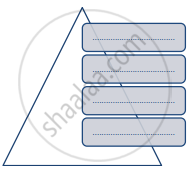Advertisements
Advertisements
Question
Give your personal response.
Jainism and Buddhism provided hope to all people.
Solution
- In the Later Vedic period, the caste system and Brahminic supremacy became entrenched. Caste groups became rigid with the passage of time.
- The varna system now turned into an oppressive Jati (caste) system. In all this, women became doubly oppressed. Jainism and Buddhism are perceived as "protest religions".
- Both these religious traditions opened their doors to all sections of society. The right to salvation was no longer limited to a particular stratum of society.
- Understandably, Buddhism with its fewer rigid rules and regulations in comparison to Jainism was embraced by many.
- Gautama Buddha permitted women to join his monastic community and to fully participate in it.
- Buddhist doctrines do not differentiate between women and men, since everyone, regardless of gender, status, or age, is subject to old age, illness, and mortality, thus suffering applies to all.
- Several Jain nuns have played a very active part in the abolition of sati practice, the abolition of slavery of women, and the prohibition of animal sacrifices.
- Jainism, being a religion of religious equality, is devoted to recognising the rights of all living creatures. Because of this, Jainism and Buddhism brought hope to the people.
RELATED QUESTIONS
What was the nature of education during the Early Vedic period?
State two indicators of the declining status of women during the Later Vedic period.
Mention any two characteristics of the Indian society in the Medieval period.
Correct the underlined word and complete the statement.
Elementary education was imparted in Khanqahs during the medieval period.
Write differences.
Status of Women in the Early Vedic Period and Later Vedic Period
Write differences.
Education in the Ancient Period and Colonial period in Indian society
The purusharthas is a part of ______ teaching.
Correct the incorrect pair and rewrite it.
| I | Ahura Mazda – Judaism |
| II | Vardhamana Mahavir – Jainism |
| III | Guru Nanak Dev – Sikhism |
| IV | Jesus Christ – Christianity |
Correct the incorrect pair and rewrite it.
| I | Brahmin – Priest |
| II | Kshatriya – Trader |
| III | Vaishya – Farmer |
| IV | Shudra – Menial work |
Identify the appropriate term from the given option in the box and rewrite it against the given statement.
DRA VIDIAN LANGUAGE FAMILY
VARDHAMAN MAHAVIR
PANDIT NEHRU
INDO-ARYAN LANGUAGE FAMILY
DANIEL LERNER
PATRIARCHY
- Considered to be ‘Kevalin’ (omniscient)
- Sociologist who coined the term ‘ modernisation’
- Kashmiri, Assamese, Bengali
- Panchsheel philosophy
- Male dominance in society
Correct the underlined word and complete the statement.
Shia and Sunni are sects in Judaism.
Correct the underlined word and complete the statement.
The Kshatriya caste includes priests, teachers and intellectuals.
Status of women in India during Early Vedic Period
Status of women in India during Later Vedic Period.
Islamic education during Medieval period
Write differences.
Brahmacharyashram and Grihasthashram
Write differences.
Zoroastrianism and Islam
Explain the following concept with example.
Madrasa
Complete the concept map.
| Pillars of Islam | |
| a. | |
| b. | |
| c. | |
| d. |
Complete the concept map.

Complete the concept map.
Caste hierarchy

Complete the concept map.
Ashramvyavastha

Answer the following question in detail (in 150-200 words).
‘Religion has an impact on society.’ Discuss with suitable examples.
Match the Columns:
| Column 'A' | Column 'B' |
| (i) Dharma | (a) refers to acquisition of wealth through the path of righteousness through hard work. |
| (ii) Artha | (b) ultimate goal of salvation from the cycle of birth and rebirth |
| (iii) Kama | (c) doing one’s duties by following the path of righteousness, without the expectation of a reward |
| (iv) Moksha | (d) sensuous pleasure or sexual union through the path of righteousness |
Differentiate between Christianity and Islam.
Correct the incorrect pain and rewrite it.
Identify the appropriate term from the given options and rewrite it against the given statement:
Doing one’s duties by following the path of righteousness, without the expectation of a reward.
Correct the underlined word, and complete and rewrite the statement:
The atman is trapped in the bondage of birth and rebirth until it can attain Dharma.
Correct the underlined word, and complete and rewrite the statement:
Pangat is the Punjabi term for the community kitchen.
Correct the underlined word, complete and rewrite the statement:
The ultimate aim of Hindus is Artha.
Differentiate between:
Traditional woman and Modern woman
